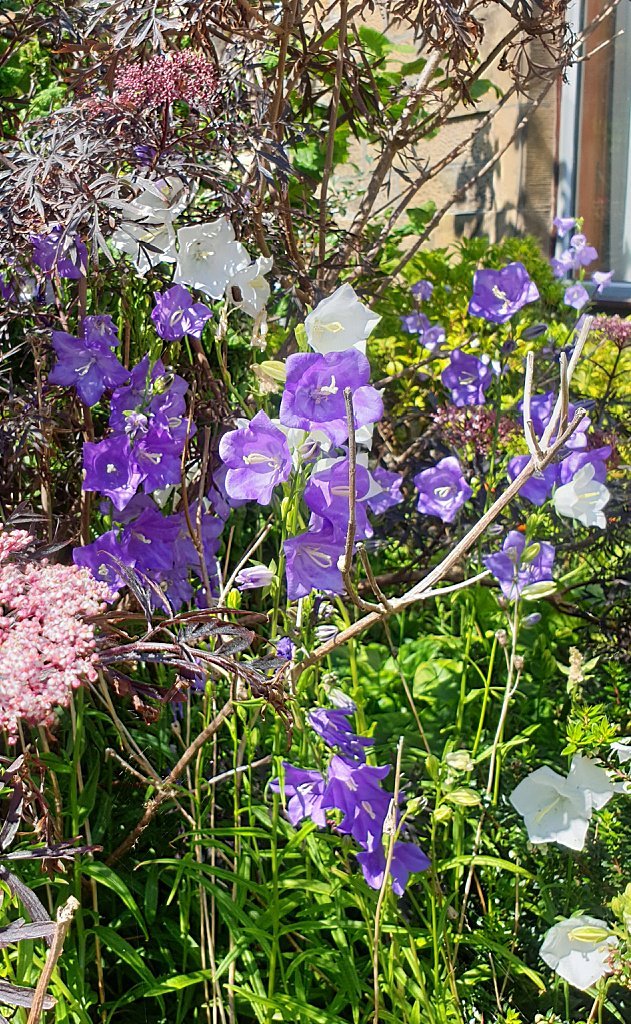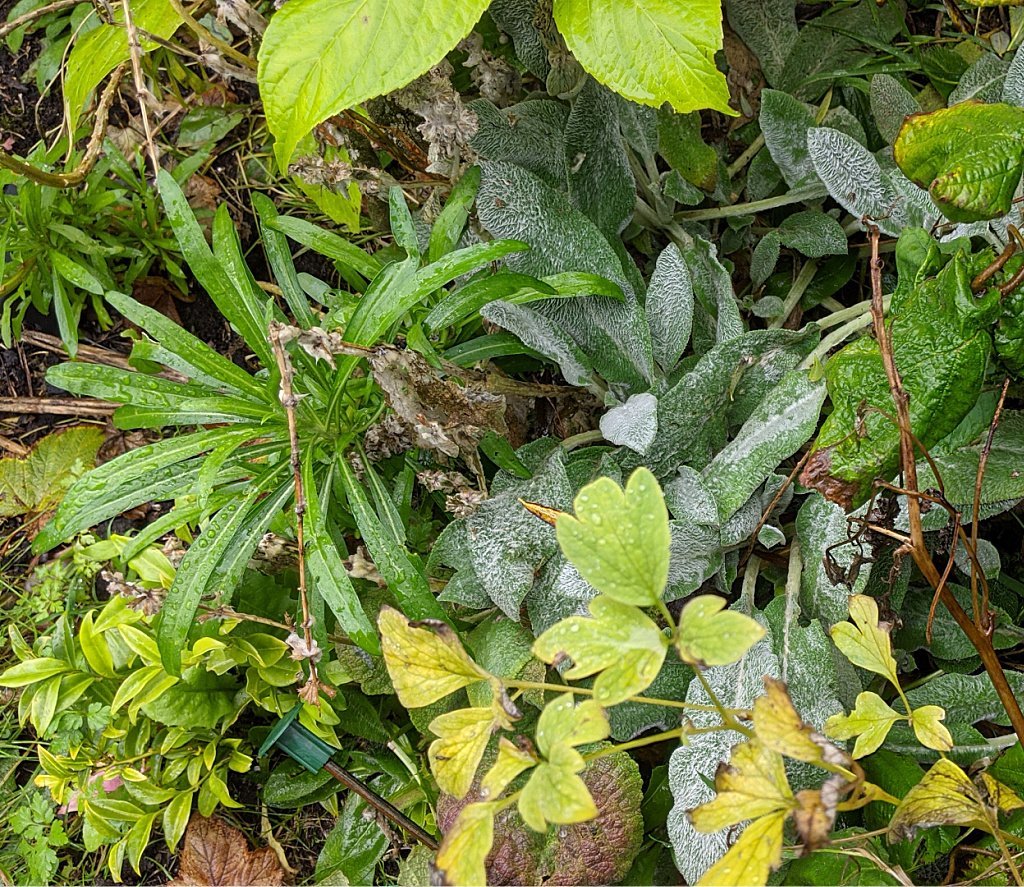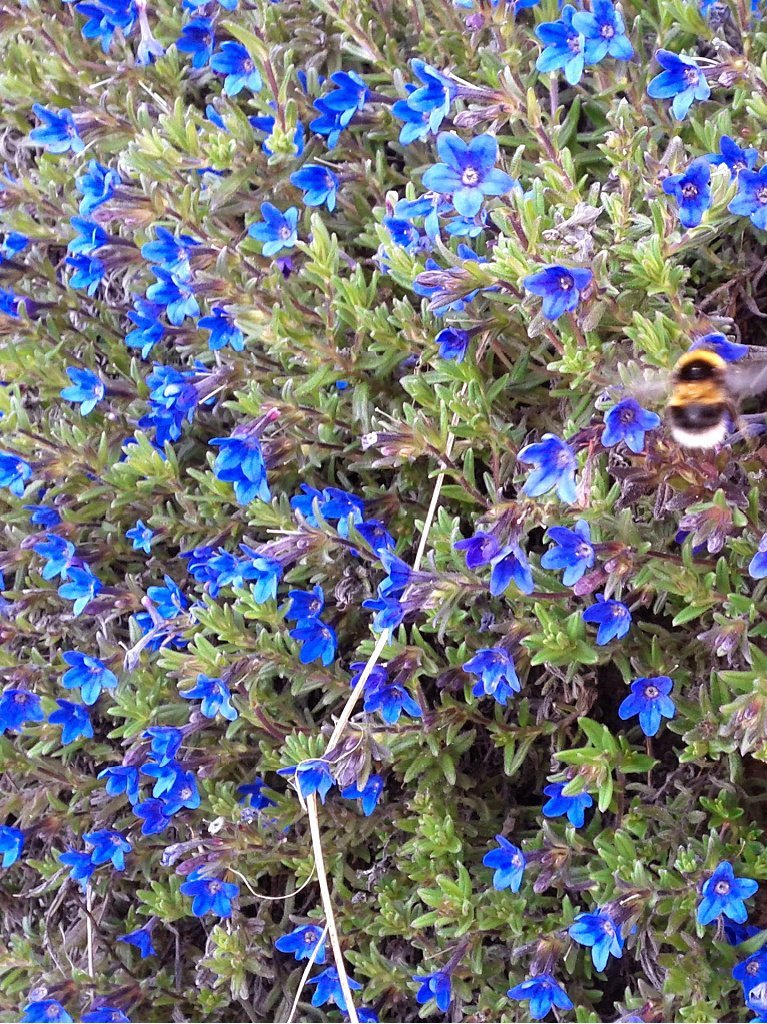When it comes to ground cover – some plants just don’t know where to stop.
With an expression like ‘ground cover’ you sometimes have to read between the lines in these gardening books and flower catalogues. ‘Ground cover’ sounds quite mild. But ‘garden hooligan’ or ‘plain thug’ might be a more accurate description.
Take the innocent-sounding periwinkle, for instance – or should I say Vinca major, to give it its Sunday name. It was here when I moved and it’s been sending out its strangulating stems in all directions ever since. The books describe it as good ground cover. Too right. The horizontal shoots root almost wherever they touch the earth.

Hah! Want to talk ground cover? This is Vinca major about to take over the world, or at least the foreshore. An extensive patch, growing only on shingle, yet still vigorously trying to smother all the other garden escapes! At least the occasional hibernating hedgehog enjoys it.
Sure, it has its place. The trouble is that its place was definitely not next to the rather attractive planting – I thought back then – of some fancy rhizomatous irises.
(Good grief, I just made up ‘rhizomatous’ to sound horticultural and, blow me, if it isn’t actually a word! At least, the spell-checker hasn’t underlined it in red.)
I teamed the iris with Celmisia, that attractive New Zealand daisy-thing. It was probably semicordata. Dunno – got it from my dad years ago.
Celmisia is in our front garden too and, can you believe it, last year a lady came to our door to ask its name. We howked out a bit for her and she went off completely delighted. Odd how it’s so seldom in garden centres when it’s so popular.
Garden thugs galore
Now, to get back to the garden thuggery. The one thing irises in general need is plenty of sunshine on the rhizomes.
As for the Celmisias, with their sword shaped silvery leaves and large daisy heads they look best when you can see their overall shape. So I turned my back and both species went knee deep in periwinkle. I turfed it out.
What else comes into this ‘plant them at your peril’ category? Well, snow-in-summer is a well known one.
This Cerastium can work wonders as ground cover for dry banks where its grey leaves and white flowers thrive when not much else will grow.
Keep these ground cover bullies away from alpines!
But keep it well away from the rock garden or any little bed where you grow wee alpines. In fact, the rockery seems to be an ideal hunting ground for all kinds of species determined to take over the plot.
There’s the innocent looking Campanula cochlearifolia ‘Alba’. This is sometimes called ‘Fairies’ thimbles’ – which is a bit toe-curling. Still, it’s got bonnie wee white bells.
It’s the sort of thing you take pity on – especially if you’re new to gardening and see it in flower in the garden centre. So you plant a wee bit.
Whoosh! Next minute it’s over the rocks, encircling your demure little alpine gems in a
pincer movement. It has the impudence to push up its leaves right through the middle of well-behaved cushion forming saxifrages.

Sometimes it has a partner-in-crime with purple flowers and round, toothed leaves. This is the less than subtle C. portenschlagiana. (Yet another name to practise saying out loud to impress garden visitors.)
Open ground, rocks, crevices, spaces in paving – it’s all the same to this one.
Before you know it, your rock garden with its artistically positioned bits of strata, is wall-to-wall campanula: a fitted carpet in mauve and green.
Anyway, if you’d read the books before you planted it, you’d see that they all say ‘invasive and long lived‘. Or ‘mat-forming’. Beware, I say, of any plant description that includes those words. You have been warned.
Invasive and long-lived ground cover. Well, look out…
Come to think of it, even the tall bellflower C persicifolia can go a bit mad by seeding – but somehow that untidy cottage garden effect is more tolerable.
Meanwhile back in the herbaceous border, I’d advise you never to turn your back on lambs’ lugs. Yes, agreed, one of the more curious sentences you’ll read today. But Stachys lanata, lambs’ lugs’ posh name, even has a variety called ‘silver carpet’ and the clue once again lies in the name.
It’s a fine grey-leaved ‘feature plant’ at the front of the border and useful for breaking up an otherwise featureless planting. (I am trying and failing to justify its existence here!) But be ruthless with the spade. Keep it chopped back to let it know who’s boss.

(Above) Oh, great. Another muddle here. The woolly-leafed Stachys lanata held in check by other toughies (wallflower and columbine). But, hang on, bottom left, there’s a very small shrub, wintersweet, (winter flowering) that hasn’t a chance in that position. Who planted that there? Added to the ‘to do’ list.

Ladies ‘Mantle’ – should have been ‘blanket’
Then in this review of misbehaving plants, there are a few that seed themselves everywhere. recently saw a garden centre selling lady’s mantle, Alchemilla mollis, in a small pot for about a fiver.
This means that by late summer I had been composting about £50 worth of seedlings for quite a few weeks, mostly germinating in the gravel. Lady’s mantle is said to be damp-loving.
Mine thrives on gravel that has weed-prevention membrane below. You can never tell what plants will do…
Talking of which, even well behaved species can go daft now and again. In one of my past gardens I had a very handsome Lithospermum diffusum planted at the dry top end of a raised bed. The experts advise adding peat and keeping conditions acid for this attractive ‘little’ blue flowered alpine.
I’d done that in previous gardens and the result was a demure little straggly affair which petered out after a few seasons.
But there it was planted in peat-free chopped up rotted turf – and it was three foot across, covered in bloom, and still growing. Perhaps it just liked me.
Edible spreaders in veg department
And finally, from the edible section of the plot, there’s mint. Just about any mint. Grow it in a bucket, a pot – in fact, any container, so long as you keep it well-watered (even standing in water for some varieties).
Otherwise, chopping bits off it to keep it within bounds just becomes another gardening chore, even if the smell is nice.
Oh, and horseradish. That kind of horse definitely needs tethering. Definitely in a container. Out in the open bed, if it gets its toes well in, you might just have to move house to escape it.
And, just a thought here, but is wallflower something that can get out of hand and seed itself around? I still kinda like it.
